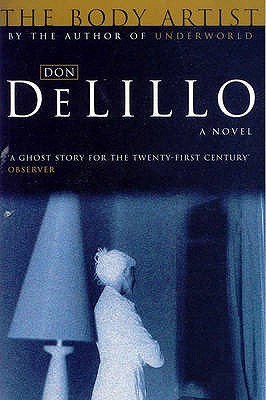Don DeLillo is an author I’ve been wanting to read for some time but have never got round to, for two reasons. The first, stupidly, is that his novel Underworld sticks in my mind as too large to entice me to read him just yet, despite there being plenty of other novels to choose from. And the second? Well, he’s considered heavyweight in the world of American letters, past and present, so – like Saul Bellow, who I never get far with – I considered myself not yet ready for him.
Not so, it seems, although I did choose a novella as my entry point. The Body Artist (2001), on reading internet scraps, is not typical of DeLillo’s work in that its canvas isn’t wide reaching but, instead, contained. Minimal, even. And, in keeping things minimal, the plot is fairly thin on the ground, too, preferring to tell the story of Lauren Hartke, a performance artist; and doing so with a fine display of writing that charts her grief, mixing in a thread of metaphysical intrigue.
The Body Artist begins with a wonderful scene where Lauren and her husband, the thrice married film director, Rey Robles, have breakfast in their rented coastal home. Over the course of this meal, described in intimate detail, they concern themselves with mundane things, such as shaking the orange juice to loosen the pulp, studying the newspaper, and turning the radio on and off…and on and off. And through all this there are stuttered conversations as they half-hear each other because they are struggle to break away from their own thoughts:
She took a bite of cereal and looked at another story. She tended lately to place herself, to insert herself into certain stories in the newspaper. Some kind of daydream variation. She did it and then became aware she was doing it and then sometimes did it again a few minutes later with the same or a different story and then became aware again.
But what Lauren doesn’t realise is this is the last she’ll see of Rey as, as the obituary following this opening chapter states, he dies of a self-inflicted gunshot to the head in the apartment of his first wife. The rest of the novel investigates Lauren’s grief, taking us deep inside her head where it seems she’s most comfortable.
With the story being this thin, DeLillo needs to generate interest somehow and he does so by having Lauren discover a young man holed up in a little used room of the house. As to who he is, she doesn’t know, and any attempt to address this is complicated by his speech being out of time, flitting from mimicked snatches of conversations between her and Rey to the words she has yet to speak in a voice that is “reedy and thin and trapped in tenses and inflections, in singsong conjugations”.
Where The Body Artist starts off as a delight it soon slides to a steady stream of Lauren’s mind working away at the nature of time and reality and, to be honest, I was lost. Bored and lost, yet this is probably the author’s intention as, in a journalist’s take on Lauren’s latest performance, I feel like part of her audience:
The piece, called Body Time, sneaked into town for three nights, unadvertised except by word of mouth, and drew eager audiences whose intensity did not always maintain itself for the duration of the show. Hartke clearly wanted her audience to feel time go by, viscerally, even painfully. This is what happened, causing walkouts among the less committed.
They missed the best stuff.
Thankfully, I was committed despite not truly “getting” The Body Artist, perhaps because I never felt it was well concluded and my mind would wander from all the philosophical content at crucial moments. The best stuff was the prose, which certainly wasn’t missed, even if I didn’t know what the hell it was all saying. But despite all the temporal discussion, I still think I enjoyed this novella and believe that I may yet get something from it. With the benefit of time, of course.

For some strange reason I bought ‘Underworld’ and trudged my way through it, but I didnt really understand or enjoy it very much and I havent dabbled with Mr DeLillo since, although I am tempted by his ‘Falling Man’.
I’ve read a few DeLillos now – Americana, Libra, Falling Man – and I think I can safely say that not fully ‘getting’ it is all part of the DeLillo experience. He’s such a good stylist though that for me I’m happy to keep trying – though I may leave Underworld for my retirement.
I read Libra for university first time round, in conjunction with Thomas Pynchon’s The Crying of Lot 49. (It was a class on American Paranoia). I remember largely being ‘meh’ about DeLillo. Didn’t really get it. Didn’t really care.
Enjoyed the Pynchon though. Always meant to read more by him. Haven’t got round to it yet, but one day…
(Excuse me, I appear to by systematically commenting on everything is reverse chronological order of posts).
Oh, this sounds so devastating! But I like it. I haven’t read any DeLillo either, I might look out for this. For what it’s worth, the opening scenes you describe remind me, somewhat unconventionally I imagine, of Lunar Park, by Bret Easton Ellis.